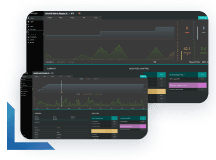
Tricentis NeoLoad addresses 9 key trends in performance engineering
In software performance testing the landscape is continuously evolving, driven by advancements in technology and the growing complexity of modern applications.
In software performance testing the landscape is continuously evolving, driven by advancements in technology and the growing complexity of modern applications. Nine key trends shaping the future of performance testing include:
- Shift-left testing
- Artificial intelligence and machine learning
- Cloud-based testing
- Infrastructure as code
- Containerization and microservices
- Performance monitoring and APM integration
- Test automation and continuous integration
- Realistic load and user simulation
- Performance testing for mobile and IoT
As organizations strive to deliver high-performing applications, it is critical for performance testing teams to keep up with these trends, leveraging solutions like Tricentis NeoLoad to ensure they remain efficient, proactive, and well-equipped to handle the challenges of testing complex applications.
1. Shift-left testing
Shift-left testing involves integrating performance testing earlier in the software development life cycle (SDLC), enabling teams to identify and address performance issues during the design and development phases. For instance, using the NeoLoad Command Line Interface (CLI), developers can create and execute performance tests during the development phase, allowing them to identify bottlenecks and optimize code before it reaches the testing or production stages.
2. Artificial intelligence and machine learning
Artificial intelligence (AI) and machine learning (ML) can enhance performance testing processes by automating test case generation, detecting anomalies, and providing predictive analytics. NeoLoad leverages AI-driven algorithms to automatically detect regressions in performance over time, giving insight to performance experts on where they should be applying their time and skills. This helps make performance testing more efficient and accurate, while eliminating the need to examine results that do not contain substantive performance degradation.
3. Cloud-based testing
Cloud-based testing enables scalable and cost-effective solutions for performance testing by leveraging cloud resources. NeoLoad supports cloud-based load testing by seamlessly integrating with cloud platforms like AWS, Azure, and Google Cloud, allowing testers to create dynamic infrastructure for performance testing to generate load from various geographic locations and simulate large numbers of virtual users without investing in expensive hardware.
4. Infrastructure as Code (IaC)
IaC enables automated setup and configuration of testing environments, ensuring consistency and reducing the likelihood of human errors. While NeoLoad itself does not provide IaC capabilities, it can be integrated with IaC tools like Terraform, Ansible, and Puppet, allowing performance testers to execute load tests against different versions of an application in a repeatable and version-controlled manner.
5. Containerization and microservices
As applications adopt containerization and microservices architectures, performance testing needs to adapt to these new environments. NeoLoad supports testing in containerized and microservices-based applications by enabling the creation of realistic load tests that focus on individual components and their interactions. It can also integrate with container orchestration tools like Kubernetes to monitor the impact of container scaling and deployments on application performance.
6. Performance monitoring and Application Performance Monitoring (APM) integration
Integrating NeoLoad with APM tools like Datadog, Dynatrace, or AppDynamics enables continuous monitoring of application performance and helps identify bottlenecks. This integration allows testers to correlate test data with real-time performance metrics, providing insights for optimization and ensuring that performance issues are addressed proactively. Additionally, the performance management teams that rely on APM solutions will also be able to view NeoLoad performance test results in their dashboards, eliminating user access control configuration and training requirements, since every consumer of performance data can do so in their preferred solution.
7. Test automation and continuous integration (CI)
Integrating NeoLoad into the CI/CD pipeline enables continuous performance testing, ensuring that every code change is evaluated for its impact on performance. By automating test script execution using CI tools like Jenkins, GitLab CI, or Travis CI, NeoLoad can provide immediate feedback on potential performance regressions and help developers address issues as they arise. The use of CI systems emphasizes the importance of IaC and AI analysis of results, as the automated setup, execution, and reporting becomes a seamless automated process.
8. Realistic load and user simulation
NeoLoad supports the creation of realistic load tests by simulating real-world user behavior and network conditions. Testers can configure various user scenarios, including think times, multiple user journeys, and different network conditions, ensuring that the application’s performance is tested under conditions that closely resemble actual user experiences. The introduction of RealBrowser in NeoLoad will further allow for the collection of true end-user experience time as rich internet experiences are faithfully rendered and executed in a browser engine.
9. Performance testing for mobile and IoT
With the increasing adoption of mobile devices and the Internet of Things (IoT), performance testing for these platforms has become crucial. NeoLoad can be used to test mobile applications and IoT devices, addressing challenges like network latency, device constraints, and ensuring the performance of applications across a wide range of devices. The impact of realistic network conditions on mobile performance tests cannot be underestimated, and as 5G network access becomes more pervasive additional use cases will begin to be explored – all of which will need to be performance tested.
Summary
These trends, combined with the capabilities of NeoLoad as a performance testing solution, contribute to making software performance testing more efficient, proactive, and reliable. The future of software performance testing is being shaped by these emerging trends, with emphasis on early detection of issues, automation, scalability, and the user experience. Shift-left testing, AI and ML, cloud-based testing, and infrastructure as code streamline the testing process, while containerization and microservices, APM integration, CI, realistic load simulations, mobile and IoT testing, and a focus on perceived performance ensure the testing covers the complexities of modern applications. Embracing these trends and utilizing performance testing solutions like NeoLoad can help organizations deliver high-performing applications, reduce costs, and improve the overall user experience.
To learn more about NeoLoad, request a free trial.


